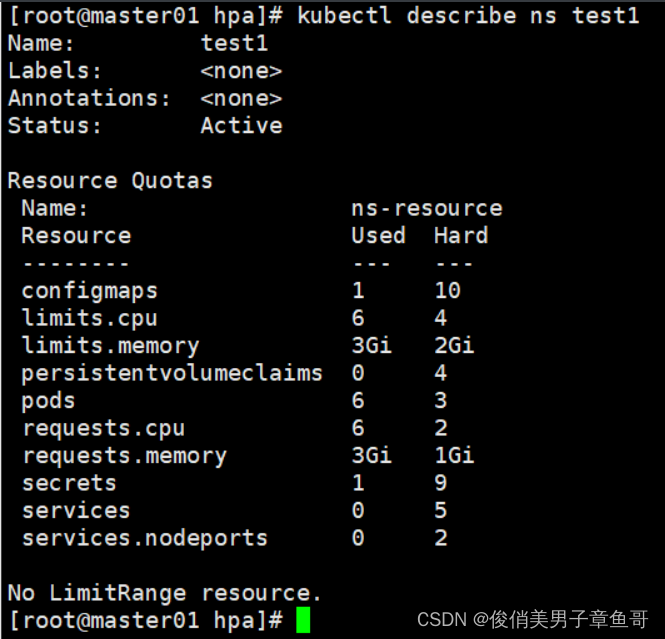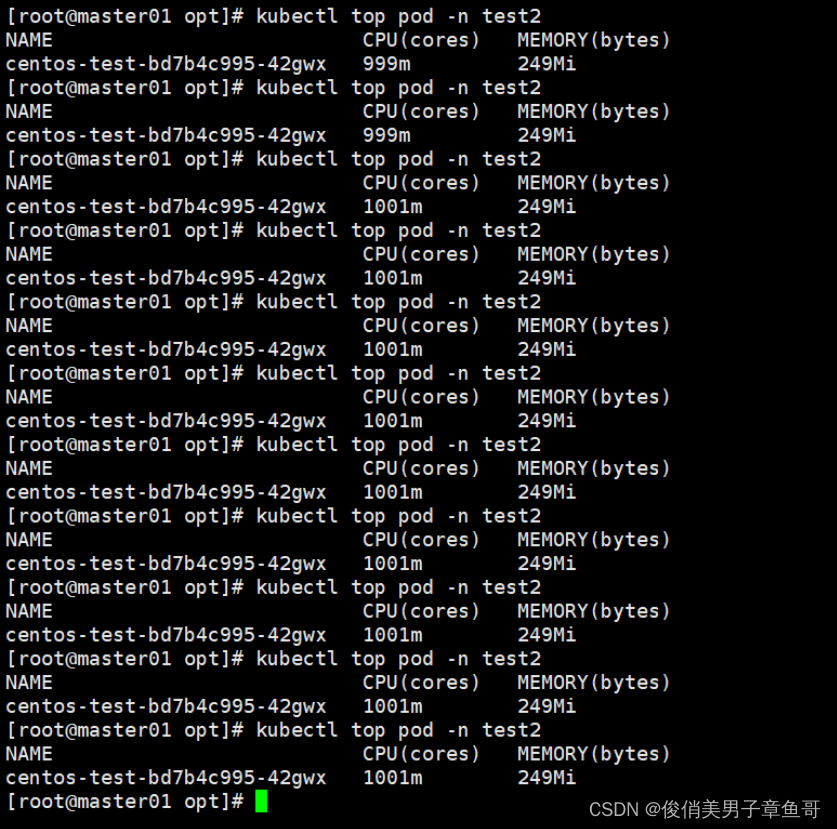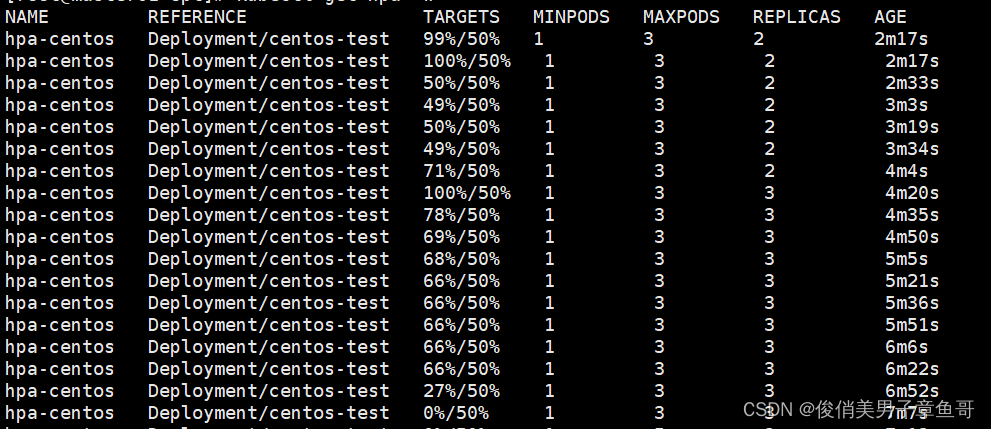HPA:Horizontal Pod Autoscaling是pod的水平自动伸缩。是k8s自带的模块
pod占用CPU的比率到达一定的阈值会触发伸缩机制。
replication controller:副本控制器。控制pod的副本数
deployment controller:节点控制器。部署pod
hpa控制副本的数量以及控制如何部署pod
-
hpa基于kube-controller-manager服务。周期性检测pod的cpu使用率,默认是30秒
-
hpa和replication controller以及deployment controller都属于k8s的资源对象。通过跟踪分析副本控制器和deployment的pod负载变化。针对性的调整目标副本数。
阀值:正常情况下,pod的副本数,以及达到阀值之后,pod的扩容最大数量。
-
metrics-server部署到集群中
实验部署
将metrics-server传入每个节点
docker load -i metrics-server.tarmaster01---
kubectl apply -f components.yaml
vim hpa-test.yaml
apiVersion: apps/v1
kind: Deployment
metadata:name: centos-testlabels:test: centos1
spec:replicas: 1selector:matchLabels:test: centos1template:metadata:labels:test: centos1spec:containers:- name: centosimage: centos:7command: ["/bin/bash", "-c", "yum -y install epel-release;yum -y install stress;sleep 3600"]resources:limits:cpu: 1000mmemory: 512Mi
#设置资源限制。使用hpa必须添加资源限制字段,否则无法判断---apiVersion: autoscaling/v1
kind: HorizontalPodAutoscaler
metadata:name: hpa-centos
spec:scaleTargetRef:apiVersion: apps/v1
#表示需要监控的类型是什么,基于什么控制器创建的kind: Deploymentname: centos-test
#这里表示你需要监控谁minReplicas: 1
#表示最小有几个maxReplicas: 5
#超过副本最大有几个targetCPUUtilizationPercentage: 50
#设定cpu使用的阀值kubectl apply -f hpa-test.yaml
进入容器使容器占满2个cpu测试

此时停止扩充测试缩容

HPA的规则
-
定义pod的时候必须要有资源限制,否则HPA无法进行监控
-
扩容是即时的,只要超过阀值就会立刻扩容,不是立刻扩容到最大副本数。他会在最小值和最大值波动,如果扩容数量满足了需求,则不会在扩容。
-
缩容是缓慢的。如果业务的峰值较高,回收的策略太积极的话,可能会产生业务的崩溃。
周期性的获取数据,缩容的机制问题。
如果业务的峰值较高,回收的策略太积极的话,可能会产生业务的崩溃。
pod的副本数扩缩容有两种方式:
1、 手动的方式修改控制器的副本数。
-
命令行可以通过 kubectl scale deployment pod名称 --replicas=5
-
修改yaml文件。通过apply -f部署更新
2、 自动扩缩容HPA
hpa监控的是cpu
资源限制
pod的资源限制:在部署pod的时候加入resources字段,通过limits/request来对pod进行限制。
除了pod的资源限制还有命名空间的资源限制
命名空间资源限制
如果你有一个lucky-cloud项目部署在test1的命名空间。如果lucky-cloud不做限制或者命名空间不做限制,他依然会占满所有集群资源。
k8s集群部署pod的最大数量:1万个
实验举例:
vim ns.yaml
apiVersion: apps/v1
kind: Deployment
metadata:name: centos-test2namespace: test1labels:test: centos2
spec:replicas: 11selector:matchLabels:test: centos2template:metadata:labels:test: centos2spec:containers:- name: centosimage: centos:7command: ["/bin/bash", "-c", "yum -y install epel-release;yum -y install stress;sleep 3600"]resources:limits:cpu: 1000mmemory: 512Mi---apiVersion: v1
kind: ResourceQuota
metadata:name: ns-resourcenamespace: test1
spec:hard:
#硬限制pods: "10"
#表示在这个命名空间内只能部署10个podrequests.cpu: "2"
#最多只能占用多个个cpurequests.memory: 1Gi
#最多只能占用多少内存limits.cpu: "4"
#最大需要多少cpulimits.memory: 2Gi
#最大需要多少内容configmaps: "10"
#当前命名空间内能创建最大的configmap的数量 10个persistentvolumeclaims: "4"
#当前命名空间只能使用4个pvcsecrets: "9"
#创建加密的secrets。只能9个services: "5"
#创建service只能5个services.nodeports: "2"
#nodeport类型的svc只能2个设置副本数为11个测试。当命名空间限制了之后,最多只能部署10个

kubectl describe ns test1
#查看命名空间的限制
通过命名空间的方式对容器进行限制
实验举例:
vim ns2.yaml
apiVersion: apps/v1
kind: Deployment
metadata:name: centos-testnamespace: test2labels:test: centos2
spec:replicas: 1selector:matchLabels:test: centos1template:metadata:labels:test: centos1spec:containers:- name: centosimage: centos:7command: ["/bin/bash", "-c", "yum -y install epel-release;yum -y install stress;sleep 3600"]---apiVersion: v1
kind: LimitRange
#表示使用limitrange来进行资源控制的类型
metadata:name: test2-limitnamespace: test2
spec:limits:- default:memory: 512Micpu: "1"defaultRequest:memory: 256Micpu: "0.5"type: Container
#对所有部署在这个命名空间内的容器统一进行资源限制
#default: limit
#defaultRequest: request
#type: Container、Pod、Pvc都可以
通过命名空间对pod进行统一限制:
好处是不需要对每个pod进行限制
缺点是不够灵活
HPA自动伸缩如果使用nodeName的方式将固定在一个node上观察扩容之后,阀值是否会下降?
实验举例:
apiVersion: apps/v1
kind: Deployment
metadata:name: centos-testlabels:test: centos1
spec:replicas: 1selector:matchLabels:test: centos1template:metadata:labels:test: centos1spec:containers:- name: centosimage: centos:7command: ["/bin/bash", "-c", "yum -y install epel-release;yum -y install stress;sleep 3600"]resources:limits:cpu: 1000mmemory: 512MinodeName: node01
#设置资源限制。使用hpa必须添加资源限制字段,否则无法判断---apiVersion: autoscaling/v1
kind: HorizontalPodAutoscaler
metadata:name: hpa-centos
spec:scaleTargetRef:apiVersion: apps/v1
#表示需要监控的类型是什么,基于什么控制器创建的kind: Deploymentname: centos-test
#这里表示你需要监控谁minReplicas: 1
#表示最小有几个maxReplicas: 5
#超过副本最大有几个targetCPUUtilizationPercentage: 50
#设定cpu使用的阀值

占满第二个pod测试



他们都处在同一个节点上
查看是阀值是否会下降

测试即使在同一个node节点上阀值还是会下降。实验完成
总结
HPA自动扩缩容
命名空间的两种方式:
-
ResourceQuota:可以对命名空间进行资源限制
-
LimitRange:直接声明在命名空间中创建的pod,容器的资源限制。这是一种统一限制。所有的pod都受这个条件的制约。
只要是在命名空间内不管创建多少,都需要使用我声明的资源限制。
pod的资源限制:resources、limit
-
pod的资源限制是我们创建时候声明好的,这时必加选项。
-
对命名空间、使用cpu、内存一定会做限制
命名空间的资源限制:ResourceQuota
-
一般是对命名空间的cpu和内存做限制
命名空间统一资源限制:LimitRange
核心:pod一定要做资源限制否则会占用集群的全部资源,命名空间也需要做限制否则还是会占用集群的全部资源。防止整个集群的资源被一个服务或者一个命名空间占满。
HPA自动伸缩

)

弱相等(==)表)



、银河麒麟操作系统中安装多个.NET版本)




)






